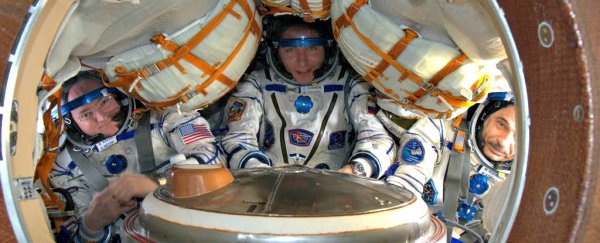Long-duration spaceflight does weird things to the human body, even at the molecular level, but so far there's no reason to think humans couldn't survive a two-and-a-half-year round-trip journey to Mars.
That was the bottom-line message Friday from a NASA official and two scientists as they revealed more results from the agency's "Twins Study," which examined physiological changes in astronaut Scott Kelly during his nearly year-long sojourn in space while his twin brother, Mark Kelly, stayed on Earth.
The full report has not yet been published, but reporters got a summary at a news conference at the annual meeting of the American Association for the Advancement of Science, in Washington.
Among the highlights: Scott Kelly's bloodwork showed that his immune system quickly ramped up when he went into space, as if, at the cellular level, his body felt under attack.
"It's almost as if the body's on high alert," said Christopher Mason, associate professor of computational genomics at Weill Cornell Medicine.
Some of the physiological effects of microgravity have long been known, such as impaired vision, bone loss, muscle loss and disruption to the wake-sleep cycle. The new research shows changes at the cellular level, including changes in gene expression.
"It's mostly really good news," Mason said. "The body has extraordinary plasticity and adaptation to being in zero gravity, at least for a year."
That was echoed by Craig Kundrot, director of NASA's space life and physical sciences division. He said so far the NASA research has found nothing that would make a Mars mission impossible. The biggest concern is radiation: Such a mission would expose astronauts to levels of radiation greater than permitted under current guidelines. That wouldn't necessarily prevent a mission, but it remains a concern.
He cautioned that the twins study has a very small study sample: two people.
"We don't regard any of this as conclusive, but on the whole it's encouraging," he said. "There are no new major warning signs."
NASA under President Trump has renewed its vow to put human beings on the moon again, and on Thursday produced a provisional plan that envisioned astronauts on the lunar surface in 2028 as part of an international effort that would include commercial partners.
The agency says that, unlike the Apollo program, the new moon program would be sustained and not merely a "flags and footprints" mission.
Any human mission beyond low Earth orbit presents a suite of health risks for astronauts because of the radiation in deep space. The technological challenges associated with a human mission to Mars are obvious, but the physiological challenges are potentially just as significant.
Kundrot said Friday that NASA envisions a Mars mission that would require a six-month flight each way plus 18 months on the Martian surface.
Such a mission might involve four to six astronauts, likely an international team. The psychological stresses of such a mission would be considerable.
"It's the ICE conditions — isolated, confined, extreme," said Steve Kozlowski, a professor of organizational psychology at Michigan State University who will make a presentation at the AAAS convention on Sunday. Kozlowski has been researching technologies that could help astronauts monitor the quality of team dynamics.
"You're going to be in a little tiny space, you're not going to have virtually any privacy," he said. The time delay in communication across millions of miles of space will make conversations with people back home essentially impossible, he said.
"Your social world is going to be you and this small group of people for a really, really long time."
2019 © The Washington Post
This article was originally published by The Washington Post.
